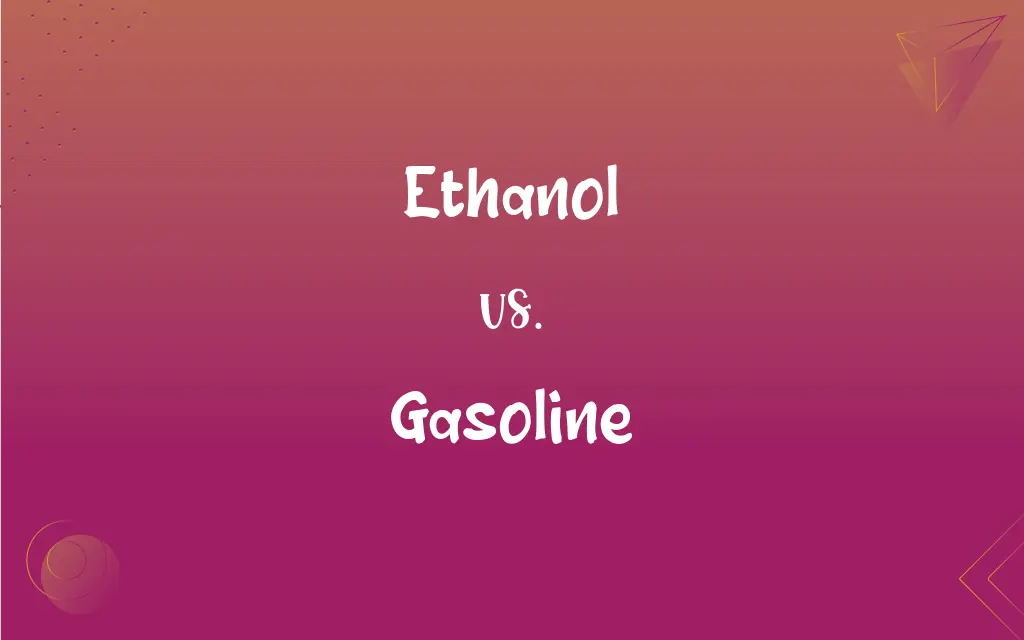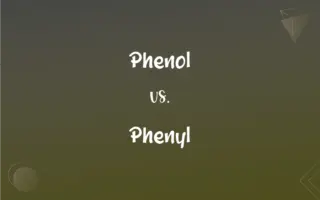Ethanol vs. Gasoline: What's the Difference?
Edited by Aimie Carlson || By Harlon Moss || Updated on October 25, 2023
Ethanol is an alcohol-based fuel derived from plants, while gasoline is a petroleum-based fuel. Both are used in combustion engines but have distinct properties and sources.

Key Differences
Ethanol and gasoline are both common fuels, but they originate from vastly different sources. Ethanol is a type of alcohol derived primarily from fermented sugars in plants, especially corn in the United States. It's renewable, given its plant-based origin. Conversely, gasoline is a refined product of crude oil, which is a non-renewable fossil fuel.
When used as fuels, ethanol and gasoline have differing energy contents. Ethanol contains less energy per gallon compared to gasoline, which can affect the mileage a vehicle gets. While gasoline has been the traditional fuel for combustion engines, ethanol is often blended with gasoline to produce fuels like E10 or E85, denoting the percentage of ethanol present.
Environmental considerations also differentiate ethanol from gasoline. Burning ethanol tends to release fewer greenhouse gases compared to gasoline, making it a cleaner alternative in that respect. However, gasoline provides better efficiency due to its higher energy content, so vehicles can travel longer on a gallon of gasoline than on a gallon of ethanol.
From an economic standpoint, the production of ethanol, especially in countries with abundant agricultural resources, can help in reducing dependency on imported oil. Gasoline, given its origin from crude oil, is subject to global market fluctuations, geopolitical issues, and extraction costs. Ethanol's price, however, is influenced more by agricultural factors than global politics.
Safety and handling of ethanol and gasoline also have distinctions. While both are flammable, ethanol has a higher octane rating than gasoline. This means it can resist knocking in engines better than gasoline. On the other hand, gasoline is more volatile, making it easier to ignite under various conditions.
ADVERTISEMENT
Comparison Chart
Word Type
Noun
Noun
Syllables
3 (Eth-a-nol)
3 (Gas-o-line)
Part of Speech
Noun
Noun
Typical Use
Describing alcohol-based fuel
Describing petroleum-based fuel
Use in Sentence
"Ethanol is derived from corn."
"Gasoline prices fluctuate often."
ADVERTISEMENT
Ethanol and Gasoline Definitions
Ethanol
An alcohol-based biofuel derived from plants.
Cars can run on a mixture of gasoline and ethanol.
Gasoline
The primary fuel for most combustion engines.
Gasoline engines have been dominant in the auto industry for decades.
Ethanol
The type of alcohol found in alcoholic beverages.
Drinking pure ethanol can be harmful to health.
Gasoline
A refined product of petroleum used as fuel.
He filled his car's tank with gasoline.
Ethanol
A solvent used in labs and industries.
Ethanol is commonly used in the pharmaceutical industry.
Gasoline
A volatile flammable liquid mixture.
Gasoline needs to be stored in well-sealed containers.
Ethanol
A renewable energy source.
The country is shifting towards ethanol to reduce carbon emissions.
Gasoline
Subject to price fluctuations based on crude oil prices.
The rise in crude oil prices caused a surge in gasoline costs.
Ethanol
A colorless volatile flammable liquid.
Ethanol is used in medical wipes and antiseptic hand sanitizers.
Gasoline
Often blended with additives to improve performance.
This gasoline contains detergents to clean engine parts.
Ethanol
See alcohol.
Gasoline
A volatile mixture of flammable liquid hydrocarbons derived chiefly from crude petroleum and used principally as a fuel for internal-combustion engines.
FAQs
What is the primary source of ethanol?
Ethanol is primarily derived from fermented plant sugars, especially corn.
Is gasoline renewable like ethanol?
No, gasoline is derived from non-renewable crude oil.
Why is gasoline more energy-dense than ethanol?
Gasoline's molecular structure, derived from crude oil, packs more energy than ethanol.
Why might some oppose ethanol production?
Concerns include using food crops for fuel and land-use changes.
Can cars run purely on ethanol?
Yes, some cars are designed to run on 100% ethanol, though blends with gasoline are more common.
Is gasoline storage hazardous?
Gasoline is flammable and should be stored carefully in approved containers.
How does ethanol influence engine performance?
Ethanol has a higher octane rating than gasoline, reducing engine knocking.
How is gasoline refined?
Gasoline is refined from crude oil through processes like distillation and cracking.
Is it safe to drink ethanol?
Ethanol is the alcohol in beverages, but pure ethanol is unsafe to drink.
Which fuel is more cost-effective?
It varies by region and availability. Ethanol might be cheaper in agricultural areas, while gasoline is globally traded.
Can gasoline be replaced by ethanol entirely?
Technically, yes, but factors like infrastructure and energy density can make gasoline preferable.
Does the U.S. produce a lot of ethanol?
Yes, the U.S. is one of the largest ethanol producers, mainly from corn.
Is ethanol better for engine health?
Ethanol can be corrosive but is also a cleaner-burning fuel. Proper engine design and maintenance are essential.
How are gasoline prices determined?
Gasoline prices are influenced by crude oil prices, refining costs, and market demand.
Why is ethanol considered a biofuel?
Because it's derived from biological sources like plants.
How does gasoline affect the environment?
Gasoline combustion releases greenhouse gases and pollutants.
Can ethanol help in reducing oil imports?
Yes, domestically produced ethanol can reduce dependency on imported oil.
Which fuel emits fewer greenhouse gases?
Ethanol generally releases fewer greenhouse gases compared to gasoline.
Are there vehicles that can run on both ethanol and gasoline?
Yes, they are called "flex-fuel" vehicles.
Can ethanol and gasoline be mixed?
Yes, fuels like E10 and E85 are mixtures of ethanol and gasoline.
About Author
Written by
Harlon MossHarlon is a seasoned quality moderator and accomplished content writer for Difference Wiki. An alumnus of the prestigious University of California, he earned his degree in Computer Science. Leveraging his academic background, Harlon brings a meticulous and informed perspective to his work, ensuring content accuracy and excellence.
Edited by
Aimie CarlsonAimie Carlson, holding a master's degree in English literature, is a fervent English language enthusiast. She lends her writing talents to Difference Wiki, a prominent website that specializes in comparisons, offering readers insightful analyses that both captivate and inform.































































